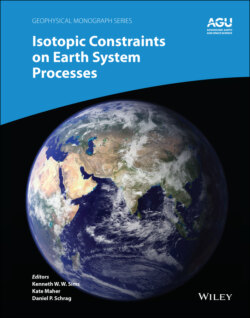Читать книгу Isotopic Constraints on Earth System Processes - Группа авторов - Страница 57
2.5.2. The Zhang (1993) Modified Effective Binary Diffusion Model
ОглавлениеThe effective binary diffusion (EBD) model (Cooper, 1968) is often used in applications where the goal is to infer timescales of magmatic processes in complex systems (cf. Zhang, 2010). In this framework, the flux of component i is proportional to its own concentration gradient:
(2.4)
where Di EBD is the effective binary diffusion coefficient (EBDC) and is sensitive to melt composition and the direction of diffusion in composition space (Liang, 2010; Zhang, 2010).
There are a number of shortcomings of the EBD model, but the main one for our purposes is that it cannot describe uphill diffusion. This led Zhang (1993) to propose a modified EBD model based on the concept of elemental partitioning between two liquids of different composition. The Zhang model treats the diffusive flux of a component as being proportional to an activity gradient instead of a concentration gradient (following Zhang’s notation, we drop the subscript i to make the expressions easier to read):
(2.5)
where γ is the activity coefficient and is the “intrinsic effective binary diffusivity.” At equilibrium, the activity (a = γC ) is uniform but there may still be concentration gradients, as would be the case for the interface between two phases or two immiscible liquids. Note that = when γ is constant. For simplicity, we adopt the simplest version of the Zhang model and assume that 1/ γ is a linear function of SiO2 concentration and is independent of the concentration of all other components. Alternatively, one might assume that the activity has an exponential dependence on SiO2 concentration (e.g., Richter, 1993), but this ultimately yields similar profiles and does not change our overall conclusions (see Supplemental Information 2.A). Regardless, for a given transient profile of SiO2, there exists an associated hypothetical “quasi‐equilibrium” profile for the equilibrium concentration of the component of interest, Ce, that scales with 1/ γ as well as the concentration of SiO2. Assuming that diffusion of SiO2 can be characterized by a concentration‐independent EBD, Db, and that diffusion of SiO2 does not reach either end of the diffusion couple, the “equilibrium” concentration profile for Ce is an error function:
(2.6)
where C− and C+ are the initial concentrations at x < 0 and x > 0 for the diffusion couple and Cf is the difference in the equilibrium concentration between the two liquids, as depicted in Fig. 2.5. The parameter Cf can be positive or negative, depending on whether the component preferentially partitions into the high‐silica or low‐silica liquid. A large Cf implies strong preference for one liquid versus the other. If Cf = 0, the model reverts back to the simplified EBD model. Replacing γ with 1/Ce in equation 2.5 yields
(2.7)
which leads to the one‐dimensional diffusion equation (Eq. 9a in Zhang, 1993):
(2.8)
where the units of concentration may be in weight percent if density can be assumed to be constant. The reason for the approximation symbol in equation 2.5 is that Zhang (1993) uses equation 2.8 to calculate concentration profiles and then calculates activity profiles from the relation a = kC/Ce, where k is the proportionality constant between Ce and 1/ γ . A point that was nuanced by Zhang (1993) is that equations 2.5 and 2.7 are not equivalent, but rather are scaled by a factor k, which can be determined from the constraint that a = C at x = 0 (interface).
Figure 2.5 The Zhang model and its parameters are based on the concept of elemental partitioning in an SiO2 gradient. The initial concentration distribution is C+ for x > 0 and C− for x < 0. At equilibrium, the concentration contrast may be reversed (depending on the sign of Cf) such that C+, eq for x < 0 and C−, eq for x > 0.
